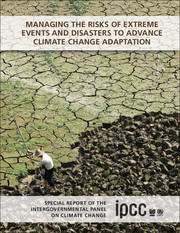 Managing the Risks of Extreme Events and Disasters to Advance Climate Change Adaptation
Managing the Risks of Extreme Events and Disasters to Advance Climate Change Adaptation from Section III
Published online by Cambridge University Press: 05 August 2012
Executive Summary
Actions that range from incremental steps to transformational changes are essential for reducing risk from weather and climate extremes (high agreement, robust evidence). [8.6, 8.7] Incremental steps aim to improve efficiency within existing technological, governance, and value systems, whereas transformation may involve alterations of fundamental attributes of those systems. The balance between incremental and transformational approaches depends on evolving risk profiles and underlying social and ecological conditions. Disaster risk, climate change impacts, and capacity to cope and adapt are unevenly distributed. Vulnerability is often concentrated in poorer countries or groups, although the wealthy can also be vulnerable to extreme events. Where vulnerability is high and adaptive capacity relatively low, changes in extreme climate and weather events can make it difficult for systems to adapt sustainably without transformational changes. Such transformations, where they are required, are facilitated through increased emphasis on adaptive management, learning, innovation, and leadership.
Evidence indicates that disaster risk management and adaptation policy can be integrated, reinforcing, and supportive – but this requires careful coordination that reaches across domains of policy and practice (high agreement, medium evidence). [8.2, 8.3, 8.5, 8.7] Including disaster risk management in resilient and sustainable development pathways is facilitated through integrated, systemic approaches that enhance capacity to cope with, adapt to, and shape unfolding processes of change, while taking into consideration multiple stressors, different prioritized values, and competing policy goals.
To save this book to your Kindle, first ensure [email protected] is added to your Approved Personal Document E-mail List under your Personal Document Settings on the Manage Your Content and Devices page of your Amazon account. Then enter the ‘name’ part of your Kindle email address below. Find out more about saving to your Kindle.
Note you can select to save to either the @free.kindle.com or @kindle.com variations. ‘@free.kindle.com’ emails are free but can only be saved to your device when it is connected to wi-fi. ‘@kindle.com’ emails can be delivered even when you are not connected to wi-fi, but note that service fees apply.
Find out more about the Kindle Personal Document Service.
To save content items to your account, please confirm that you agree to abide by our usage policies. If this is the first time you use this feature, you will be asked to authorise Cambridge Core to connect with your account. Find out more about saving content to Dropbox.
To save content items to your account, please confirm that you agree to abide by our usage policies. If this is the first time you use this feature, you will be asked to authorise Cambridge Core to connect with your account. Find out more about saving content to Google Drive.